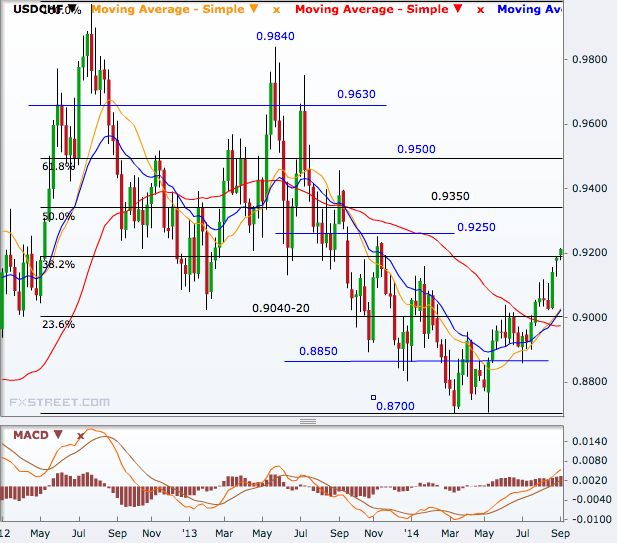Swiss Franc Falls to 10-Month Low as GDP Data Disappoints
Swiss franc falls against US dollar after data reveals GDP did not grow in Q2

The Swiss franc has fallen to a fresh 10-month low against the US dollar on 2 September, after the second-quarter GDP data came weaker than expected.
The Swiss economy expanded only 0.6% from a year earlier in the three months to June, sharply below the 2.1% growth of the previous quarter and the consensus of 1.7%.
Sequentially, the GDP growth was nil in Q2 while analysts were expecting a 0.5% expansion, in line with the Q1 reading.
The USD/CHF rate rose as high as 0.9210, its highest since November 2013, from the previous close of 0.9196. The pair had been on the rise for more than two months.
The Swiss currency has fallen more than 3.4% against the dollar over July and August, and September has seen the trend continuing.
The Q2 GDP Data
Data on Tuesday showed that household consumption and non-profit organizations' expenditure both increased 0.2% in Q2 from the previous quarter.
Positive contribution came from the housing, recreation, and culture sectors, while expenditure on healthcare delivered negative contributions.
General government and social security consumption expenditure fell for the second time in succession, by 0.3%.
At the same time, gross fixed investments remained at the same level as in the first quarter. Investments in equipment rose 0.7%, while construction investments fell by the same margin.
Other Indicators
The KOF Swiss Leading Indicator – a key data point from Switzerland – has also been showing weaker signals for the past two months.
The index fell below the zero mark in July to -2.1, and remained in the territory in August with a -0.5 reading.
In addition, price pressures are very weak in the Swiss economy. The year-over-year inflation rate has been 0% in the latest two readings and in four of the past five readings.
The unemployment rate and inflation data for August and July retail sales data are due on 8 September. After that, the producer price inflation is scheduled on 15 September, ahead of the rate decision by the Swiss National Bank on 18 September.
The Swiss National Bank, at its 19 June meeting, left the target range for the three-month Libor rate on hold at 0.0–0.25%, and maintained its EUR/CHF floor rate at 1.20.
USD/CHF Technical Outlook
The moving average convergence divergence (MACD) and the crossing over of the moving averages have triggered a clear bullish signal for the pair.
The pair has now broken above the 38.2% Fibonacci retracement of the sell-off from July 2012 to March this year, and the immediate resistance line is at the 50% level of 0.9350. The 0.9250 mark may offer some resistance though.
A break above the 50% mark will open doors to the 0.9500 area. A decisive break of that kind is unlikely to see many stops before nearing the parity mark. However, 0.9630 and 0.9840 are the two levels to watch before the parity level.
On the downside, the 0.9040-0.9020 area has become a major support line, a break of which can still lead the downtrend active. The next level will be 0.8850 ahead of a retest of the March low of 0.8700.

© Copyright IBTimes 2025. All rights reserved.






















